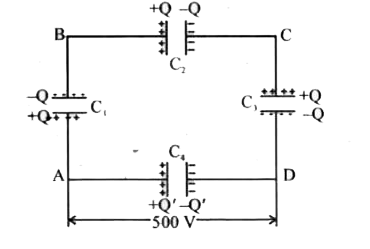Complete Solutions to EXAMPLES of chapter ELECTROSTATIC POTENTIAL AND CAPACITANCE of Class 12 book with complete answers and questions
| Class 12 | PHYSICS |
| Chapter | ELECTROSTATIC POTENTIAL AND CAPACITANCE |
| NCERT TAMIL | EXAMPLES |
| Number Of Questions | 10 |
| Academic Year | 2023-24 |
(a) Calculate the potential at a point P due to a charge of `4xx10^(-7) C` located 9 cm away.
(b) Hence obtain the work done in bringing a charge of `2xx10^(-9) C` from infinity to the point P. Does the answer depend on the path along which the charge is brought ?
View SolutionTwo charges `3xx10^(-8)C and -2xx10^(-8)C` are located 15 cm apart. At what point on the line joining the two to be charges is the electric potential zero ? Take the potential at infinity to be zero.
View SolutionFigures (a) and (b) show the field lines of a positive and negative point charge respectively.

(a). Gives the sign of the potential difference `V_(P)-V_(Q) : V_(B)-V_(A)`
(b) Given the sign of the potential energy difference of a small negative charge between the points Q and P, A and b
(c) Give the sign of the work done by the field in moving a small positive charge from Q to P.
(d) Give the sign of the work done by external agencyin moving a small negative charge from B to A.
(e) Does the kinetic energy of a small negative charge increase or decrease in going from B to A?
View SolutionFour charges are arranged at the comers of a square ABCD of side d, as shown in Fig.
a. Find the work required to put together this arrangement
b. A charge `q_(0)` is brought to the centre E of the square, the four charges being held fixed at its corners. How much extra work is needed to do this?n
View Solution(a) Determine the electrostatic potential energy of a system consisting of two charge `7 muC and -2 muC` (and with no external field) placed at `(-9 cm, 0,0) and (9 cm, 0,0)` respectively.
(b) How much work is required to seperate the two charges infinitely away from each other ?
(c) Suppose that the same system of charges is now placed in an external electric field `E = A xx 1//r^(2)`, where `A = 9xx10^(5) C m^(-2)`.
What would the electrostatic energy of the configuration be ?
View SolutionA molecule of a substance has a permanent electric dipole moment of magnitude `10^(-29) `C m. A mole of this substance is polarized at low temperature by appling a strong elecrostatic field of magnitude `10^(6) V m^(-1)`. The direction of the field is suddenly changed by an angle of `60^(@)`. Estimate the heat released by the substance in aligning its dipole along the new direction of the field. For simplicity, assume `100%` polarisation of sample.
View Solution(a) A comb run through one’s dry hair attracts small bits of paper. Why? What happens if the hair is wet or if it is a rainy day? (Remember, a paper does not conduct electricity.)
(b) Ordinary rubber is an insulator. But special rubber tyres of aircraft are made slightly conducting. Why is this necessary?
(c) Vehicles carrying inflammable materials usually have metallic ropes touching the ground during motion. Why?
(d) A bird perches on a bare high power line, and nothing happens to the bird. A man standing on the ground touches the same line and gets a fatal shock. Why?
View SolutionA slab of material of dielectric constant K has the same area as the plates of a parallel capacitor, but has a thickness `((3)/(4) d)`,
where d is the separation of the plates. How is the capacitance changed when the slab is inserted between the plates
View SolutionA network of four `10muF` capacitors is connected to a 500 V supply, as shown in figure. Determine (a) the equivalent capacitance of the network and (b) the charge on each capcitor.

View SolutionA 900pF capacitor is charged by 100 V battery as in figure (a). How much electrostatic energy is stored by the capacitor?
(b). The capacitor is disconnected from the battery and connected to another 900pF capacitor as in figure (b). What is the electrostatic energy stored by the system?
View Solution
EXAMPLES questions and complete solutions for chapter ELECTROSTATIC POTENTIAL AND CAPACITANCE of FULL MARKS PHYSICS(TAMIL) of Class 12